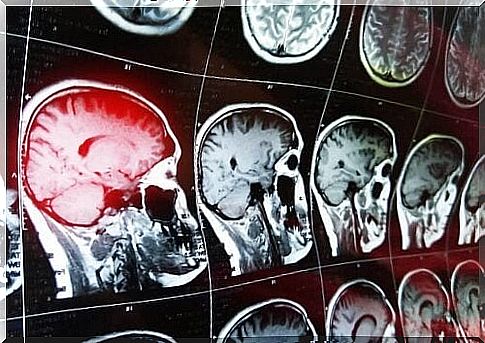Confabulation: Learn All About This Memory Error

Within the range of cognitive processes that human beings have, memory is one of the most studied. Even so, it’s still a complex issue. To understand what confabulation is, it is important to know that it originates from the distortion of some memories.
Our memories are not exact reproductions of events. Everyone can remember an event differently and guarantee that that’s how it happened. It is a deformation of reality due to loss of information.
A clear example occurs in elderly people who have a major neurocognitive disorder (senile dementia). They guarantee that they experienced something completely different from real events.
Types and classification
Confabulation is a cognitive phenomenon that is difficult to typify, as it can take many forms. However, there are 5 criteria to classify these cognitive alterations. Let’s see below what they are.
1. Spontaneous confabulation
This first type of confabulation is the one that lasts the least. They are fanciful ideas that are asserted as real events by the person, in a blunt way. It usually occurs in patients with Korsakoff syndrome.
2. Confabulation provoked
In this case, what happens is that the memory cannot recall something precisely. It is common in patients with amnesia. Something similar happens when a healthy person tries to forcibly retain some information for long periods of time.
For example, studying for an exam can literally cause memory failures. At the time of evaluation, some concepts can be exchanged and affirmed as true, even if they do not correspond to reality.

3. Simple Triggered Intrusions
These distortions appear when a person is forced to evoke information in detail. Let’s imagine for a moment that we forgot the shopping list and tried to remember what it said. Unconsciously, we might buy something that wasn’t listed but that we remember that way.
4. Momentary confabulation
This type of memory failure is the most common in confabulations. It is a fantastic account that seems to be perfectly believable.
However, it ‘s easy to spot him. It occurs, for example, when a patient recounts his plans in detail, but it is evident that they are impossible to carry out. It is common in nursing homes when some elderly people say they will visit their childhood or teenage friends, even if they have passed away.
5. Fantastic confabulation
This type of confabulation is the most intense due to the high distance from reality it presents. As the name suggests, these are fantastic stories that only have credibility for the patient. These disturbances of reality are common in patients with psychotic and paralytic dementia.
Another classification
This classification of the 5 types we have seen is proposed by Kopelman and is the most accurate to determine the intensity and frequency of confabulations. Another method that has been used over the years is the one proposed by Schnider, which consists of 4 criteria:
- Content : Establishing the reliability of the story within limits ranging from true to false.
- Way they appear : spontaneous or provoked.
- Areas in which it manifests : episodic, autobiographical, general semantics or personal semantics.
- Clinical syndrome in which they occur.
What symptoms are related to confabulation?
The symptoms of confabulations vary depending on the underlying disorder causing them. For example, in patients with Alzheimer’s, the most characteristic signs are cognitive deficit, mental decline and memory problems.
Let’s see other symptoms that may appear according to the neurological disorder:
- Dementia : memory impairment with nervousness.
- Schizophrenia : thought disorder, acoustic hallucinations, paranoia.
- Korsakoff syndrome: recent memory loss, mania and repetitive behaviors.
- Asomatognosia : inability to integrate the parts of the body or recognize them, false sensations associated with the loss of a limb.
Possible causes of confabulation
The causes of memory failures caused by confabulations in patients are the product of damage to the frontal area of the brain. In particular, the affected area is the basal anterior, where the orbitofrontal and ventromedial areas meet.
There are three theories that try to explain the reasons why confabulations occur. Below, we detail what they are. It is important to know that these hypotheses come from a neuropsychological perspective.
1. Memory dysfunction
This theory states that confabulation is a form of amnesia. The main postulate holds that memory failures are a way of making sense of incomplete memories that can be retrieved by patients. This hypothesis has great approval.
2. Executive dysfunction
Executive dysfunction theory states that when there are severe mental limitations in terms of planning and setting specific goals, memory failures occur that give rise to confabulations.
3. Double Hypothesis
In this hypothesis, the approach does not discard any of the previous postulates and maintains that confabulations are due to a deficit in executive processes (higher functions of consciousness), in addition to memory failures.
How can we handle this problem?

Although confabulations are considered non-treatable sequelae, there is an approach capable of improving the quality of life of patients who confabulate after suffering a traumatic brain injury. It is a neuropsychological procedure that is based on confrontation as a means of cognitive stimulation.
This treatment was designed by researchers at the University of Granada. It consists of showing the patient a series of images in sequence that may vary in content; they are then asked to remember what they saw. At the moment of remembrance, the confabulation takes place, and that is where the specialists interpellate.
They indicate to patients that the memory they judge to be true is false, and the images are shown to them again, at the same time as their memory failure is explained. In neuropsychology, this process is called feedback . After 9 sessions, you can expect an improvement.
What to do if we meet someone who confabulates?
If you know a person who may be engaging in some kind of confabation, the best thing to do is not to bluntly insist that they are wrong. Remember that for these patients they are talking about a real event. We must show empathy and avoid creating stress.
The next step is to consult an expert who can assess you and determine the intensity of the damage to establish the way forward. Some patients stop confabular after a while and don’t need to be hospitalized.








